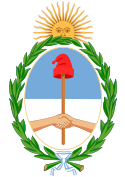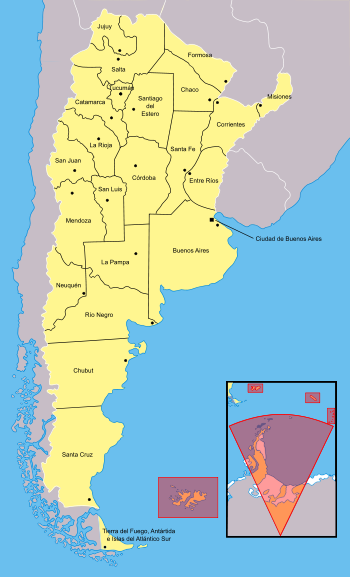Provinces of Argentina
| Argentina |
 This article is part of the series: |
|
|
|
|
Other countries · Atlas |
Argentina is subdivided into twenty-three provinces (Spanish: provincias, singular provincia) and one autonomous city (Ciudad autónoma de Buenos Aires, informally the Capital Federal). The city and the provinces have their own constitutions, but exist under a federal system.
Provinces are then divided into departments (Spanish: departamentos, singular departamento), except for Buenos Aires Province, which is divided into partidos.
Contents |
First-level Political divisions of Argentina
Provinces of Argentina and Autonomous City of Buenos Aires
a Not a Province. Autonomous City and seat of National Government. |

 Map of the provinces of Argentina. Note that areas in orange are disputed: the Falkland Islands and South Georgia and the South Sandwich Islands are under British effective control; and claims to Antarctica are regulated by the Antarctic Treaty, and overlap claims by the United Kingdom and Chile.
|
Demographics
| Province/District | Capital | Population (2001) | Rank | Area (km²) | Rank | Density (/km²) | Rank |
|---|---|---|---|---|---|---|---|
| Buenos Aires | - | 2,776,138 | 4 | 203 | 24 | 13,675.6 | 1 |
| Buenos Aires Province | La Plata | 13,827,203 | 1 | 307,571 | 1 | 44.95 | 3 |
| Catamarca Province | S.F.V. de Catamarcaa | 334,568 | 20 | 102,602 | 11 | 3.26 | 19 |
| Chaco Province | Resistencia | 984,446 | 9 | 99,633 | 12 | 9.90 | 11 |
| Chubut Province | Rawson | 413,237 | 18 | 224,686 | 3 | 1.84 | 23 |
| Córdoba Province | Córdoba | 3,066,801 | 2 | 165,321 | 5 | 18.60 | 6 |
| Corrientes Province | Corrientes | 930,991 | 11 | 88,199 | 16 | 10.60 | 10 |
| Entre Ríos Province | Paraná | 1,158,147 | 7 | 78,781 | 17 | 14.70 | 7 |
| Formosa Province | Formosa | 486,559 | 16 | 72,066 | 19 | 6.75 | 14 |
| Jujuy Province | San Salvador de Jujuy | 611,888 | 14 | 53,219 | 20 | 11.50 | 8 |
| La Pampa Province | Santa Rosa | 299,294 | 21 | 143,440 | 8 | 2.00 | 22 |
| La Rioja Province | La Rioja | 289,983 | 22 | 89,680 | 14 | 3.23 | 20 |
| Mendoza Province | Mendoza | 1,579,651 | 5 | 148,827 | 7 | 10.61 | 9 |
| Misiones Province | Posadas | 965,522 | 10 | 29,801 | 21 | 32.40 | 4 |
| Neuquén Province | Neuquén | 474,155 | 17 | 94,078 | 13 | 5.00 | 16 |
| Río Negro Province | Viedma | 552,822 | 15 | 203,013 | 4 | 2.72 | 21 |
| Salta Province | Salta | 1,079,051 | 8 | 155,488 | 6 | 6.94 | 12 |
| San Juan Province | San Juan | 620,023 | 13 | 89,651 | 15 | 6.92 | 13 |
| San Luis Province | San Luis | 367,933 | 19 | 76,748 | 18 | 4.80 | 17 |
| Santa Cruz Province | Río Gallegos | 196,958 | 23 | 243,943 | 2 | 0.81 | 24 |
| Santa Fe Province | Santa Fe | 3,000,701 | 3 | 133,007 | 10 | 22.56 | 5 |
| Santiago del Estero Province | Santiago del Estero | 804,457 | 12 | 136,351 | 9 | 5.90 | 15 |
| Tierra del Fuego Province | Ushuaia | 101,079 | 24 | 21,263b | 23 | 4.75b | 18 |
| Tucumán Province | San Miguel de Tucumán | 1,338,523 | 6 | 22,524 | 22 | 59.42 | 2 |
a San Fernando del Valle de Catamarca.
b Not including claims to the Falkland Islands or Argentine Antarctica.
Politics
See also List of Governors in Argentina
Each province has also its own government, with a provincial constitution, a set of provincial laws and justice system, a supreme court, a governor, an autonomous police force (independent of the Federal Police), and a congress: in eight provinces the parliament is constituted by an upper chamber (senate) and a lower chamber (deputies), while in the remaining fifteen provinces and in the Autonomous City of Buenos Aires the congress has just one chamber.[1]
On occasion the national government intervenes in a province under internal instability or after a corruption scandal, designating an intervenor to replace the local government until the situation is normalized: since the return of democracy to the country in 1983, four provinces were intervened, namely Catamarca, Corrientes (twice), Santiago del Estero (twice) and Tucumán.[2]
During the 20th century, some provinces have had governments traditionally controlled by a single family (i.e. the Saadi family in Catamarca, or the Sapag family in Neuquén); in one case, it is still the situation as of 2009: the Province of San Luis was ruled almost without a break by the Rodríguez Saá family since december of 1983.[3]
The internal products of the provinces are merged into the national product when the national budget is decided. The share of the budget given to each province is decided based on each province's individual contribution to the national budget. Provinces are free to choose their own utilization of their assigned percentages of the national product.
History
The north of Argentina was the first part of the present country to be explored by the Spanish colonisation, searching for the routes that would allow them to bring the gold and silver extracted in the Viceroyalty of Peru to the port of Buenos Aires.
Santiago del Estero, in the year 1550, was the first city founded in the territory with such ends, but lost its importance when Tucumán and Salta replaced it as mid-stops to the Atlantic coast when these two cities secured from the aboriginal attacks, and economically strengthened.
The centre of the country was also soon explored and inhabited, being the most important of the first founded cities the city of Córdoba, that became not only a political but also cultural centre with the creation of the first university, the Universidad Nacional de Córdoba in 1622.
Most capital cities of the centre-northern Argentina were founded before the year 1600, except for Santa Rosa in La Pampa Province, and Resistencia in Chaco Province.
To the south of the Colorado River, the Patagonia remained under control of the aboriginals. The river itself served as natural frontier.
It was not until the infamous Roca's Conquest of the Desert, started in 1879, when the southern part of Argentina was conquered in what meant the near annihilation of the aboriginal people living in these lands.
The current political division of the provinces of Patagonia was set in 1884 and has not been changed since then, except between 1944 and 1955 when a stripe covering the southern part of Chubut Province and the northern part of Santa Cruz Province was named Comodoro Rivadavia Military Zone.
But the National Territories didn't have provincial status until the 20th century. They were named provinces in 1957. The exception is Tierra del Fuego Province, which was named in 1990.
Due to the late conquest of the south of the country and the prevailing cold weather, most people live in the central or northern provinces. Recent immigration to the south, mainly from Buenos Aires Province and Buenos Aires city, is lessening this difference.
Geographical Regions
The country is also divided into six or seven regions (seven when The Pampas is divided into the Pampas' plains and Pampas' sierras):
| Region | Provinces included |
|---|---|
| Argentine Northwest | Jujuy, Salta, Tucumán, Catamarca, La Rioja |
| Gran Chaco | Formosa, Chaco, Santiago del Estero |
| Mesopotamia | Misiones, Entre Ríos, Corrientes |
| Cuyo | San Juan, Mendoza, San Luis |
| The Pampas | Córdoba, Santa Fe, La Pampa, Buenos Aires |
| Patagonia | Rio Negro, Neuquén, Chubut, Santa Cruz, Tierra del Fuego |
Even though there are provinces that belong to more than one region, they are shown here within the most representative region. In the Tucumán province, the smallest of Argentina, coexist three regions: the Pampas to the south, Gran Chaco to the northeast, and Argentine Northwest.
See also
- List of Governors in Argentina
- ISO 3166-2:AR, the ISO codes for the provinces of Argentina.
- List of Argentine Provinces by Human Development Index
- List of Argentine provinces by GDP (nominal)
- List of Argentine provinces by GDP (nominal) per capita
- Comparison between Argentine provinces and countries by GDP (PPP) per capita
External links
- Argentine provinces
- (Spanish) Information of Argentine provinces
- (Spanish) Provincias Argentinas
- (Spanish) Territorial Division
- Provinces' Flags and Governors since 1983
References
- ↑ Legislaturas distritales en Argentina (in Spanish)
- ↑ Intervenciones en la historia (in Spanish)
- ↑ Gobernadores provinciales de la República 1983-2009 (in Spanish)
|
||||||||
|
||||||||||
|
||||||||||